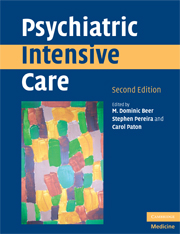Book contents
- Frontmatter
- Contents
- List of contributors
- Preface to second edition
- Preface to first edition
- Foreword
- Part I Therapeutic interventions
- Part II Interface issues
- 13 The provision of intensive care in forensic psychiatry
- 14 The interface with forensic services
- 15 Supporting people with learning disabilities on general psychiatric wards, PICUs and LSUs
- 16 The interface with general psychiatric services
- 17 The interface with the Child and Adolescent Mental Health Services (CAMHS)
- 18 Severe mental illness and substance abuse
- 19 Social work issues in PICUs and LSUs
- 20 User and carer involvement
- Part III Management of the Psychiatric Intensive Care Unit/Low Secure Unit
- Index
- References
16 - The interface with general psychiatric services
from Part II - Interface issues
Published online by Cambridge University Press: 22 August 2009
- Frontmatter
- Contents
- List of contributors
- Preface to second edition
- Preface to first edition
- Foreword
- Part I Therapeutic interventions
- Part II Interface issues
- 13 The provision of intensive care in forensic psychiatry
- 14 The interface with forensic services
- 15 Supporting people with learning disabilities on general psychiatric wards, PICUs and LSUs
- 16 The interface with general psychiatric services
- 17 The interface with the Child and Adolescent Mental Health Services (CAMHS)
- 18 Severe mental illness and substance abuse
- 19 Social work issues in PICUs and LSUs
- 20 User and carer involvement
- Part III Management of the Psychiatric Intensive Care Unit/Low Secure Unit
- Index
- References
Summary
Introduction
The development of Psychiatric Intensive Care Units (PICUs) as originally outlined some years ago (Beer, et al. 1997) has very much followed an ad hoc pattern, depending on local demand and local champions. Likewise, the way in which individual PICUs have become embedded in the provision of general psychiatric services, to a defined catchment area or district, has not been systematically studied. The location of units varies, from being part of an acute general hospital with other wards on site, to stand-alone buildings, within or outside a general or mental hospital area. A further problem is that there has been no established consensus as to the siting or size of adult psychiatric inpatient units, although the Royal College of Psychiatrists' Report, Not Just Bricks and Mortar (Royal College of Psychiatrists, 1998), attempted to look at these issues in the context of new developments and their appropriate conformation, staffing and setting. Of course, general psychiatric services are much more than just ‘bricks and mortar’, their components being a comprehensive provision of care for individuals with a wide range of disorders, and thus requiring a combination of diagnostic and treatment skills, with multidisciplinary staffing, for both inpatient and community-based services. It is now generally accepted that a pragmatic balance of both community and hospital services is necessary in all areas (Thornicroft and Tansella 2004), and that general adult psychiatry must integrate care, as seamlessly as possible, from the GP surgery to the inpatient unit, and back out into the community.
- Type
- Chapter
- Information
- Psychiatric Intensive Care , pp. 220 - 228Publisher: Cambridge University PressPrint publication year: 2008

